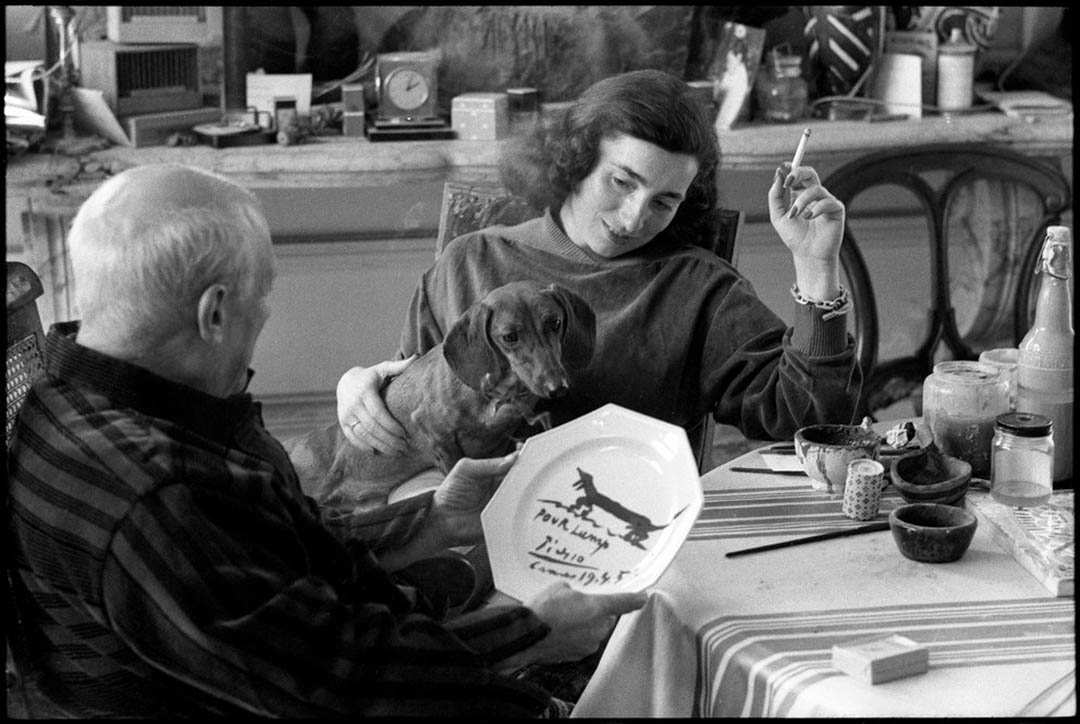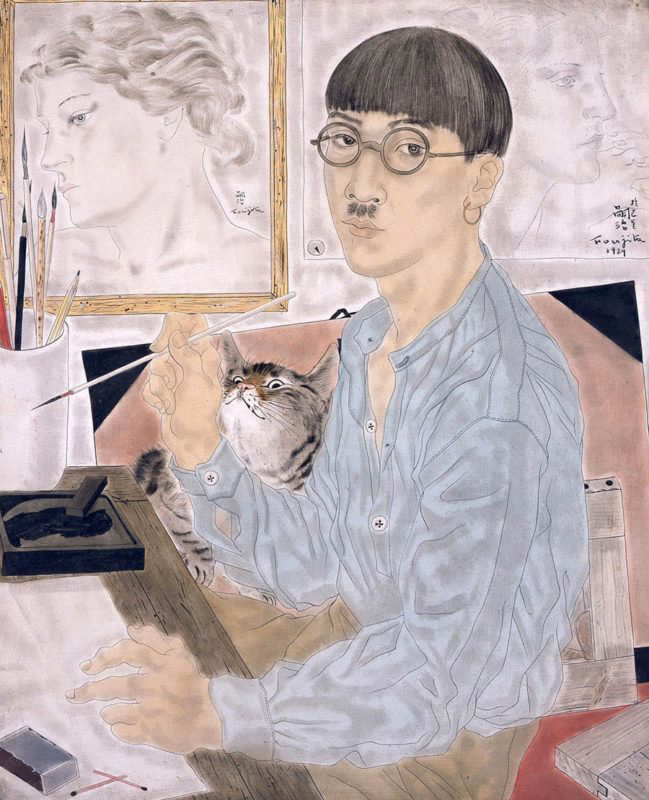
Inspiration is hard to come by, even for artists. Some turn to nature, some to family, and some (like the artists featured here) to pets. These artists loved their pets so much that they’d put them in their paintings every once in a while. Here’s a pick of the top 10 artists who made use of this inspiration with pet portraits.
Artists and Pet Portraits: Dog Portraits
Picasso And Lump

Pablo Picasso collected a minivan worth of pets he could love. This Spanish painter, like Matisse, loved animals too. That’s probably why the two were such good friends. Picasso had cats and the occasional goat, but his canine friends far outnumbered the others.
Lump met Picasso quite by accident. David Douglas Duncan, a famous war photographer, had taken his dachshund along on one of his visits to Picasso’s house. Duncan’s dog and the artist got on like a house on fire. The photographer didn’t mind because Lump wasn’t exactly friendly with his other dog. Picasso could have him.
This little sausage dog never asked Picasso to paint him like one of his French girls, but he did get a few pet portraits. Dog is all about Lump. In traditional Picasso minimalism, he is rendered in a single line. The legend even painted the doggo on a dinner plate for Duncan to take home.
Get the latest articles delivered to your inbox
Sign up to our Free Weekly Newsletter
David Hockney And His Dachshunds

Artists seem to have a type. The dachshund rules the roost when it comes to the favored choice of pet. David Hockney joined the club in the 1980s after four of his friends lost their lives to AIDS. He got Stanley first, a chocolate sausage dog. Two years later, the artist decided to give Stan a brother, Boodgie. The two of them slept together, ate together, and followed Hockney everywhere.
By the time Stanley was eight years old, Hockney came up with a great project idea. For three months straight, he painted dog portraits everywhere he could. The artist’s pets were usually found asleep on their bed, snuggled into a wholesome ball of dachshund goodness.
Dog Days came out in 1995. It is a gigantic book full of pet portraits featuring Stanley and little Boodgie. That has got to be the best coffee table book in the world.
Lucian Freud And Pluto

Lucian Freud loved the company of dogs. His first pet portrait, Girl with a white dog (1950-51) features his first wife and a bull terrier. The dog was gifted to the couple in the 1950s.
In 1988, Lucian brought a little whippet puppy home. He called her Pluto. The artist’s pet appeared in numerous dog portraits. They spent 12 years together, at the end of which Freud immortalized him in Pluto aged twelve (2000). Sometimes, he would call his friend David Dawson to bring in his dog, Eli. She happened to be a gift from Freud. He painted the dogs together, sometimes with David. Freud spent a lot of time with Eli after Pluto died. She probably reminded him of her grand-aunt.
Franz Marc And Russi

Contrary to popular belief, Franz Marc‘s Siberian Shepherd was not called Ruthie. Russi was around when the German artist decided to shift his focus on animals. Marc believed that animals were the key to salvation, that they were pure. The human race couldn’t live up to that kind of purity.
Russi hung out with all of Marc’s friends, especially August Macke. He even drew him into dog portraits. She was a trooper, following Marc everywhere he’d go. He lost a bit of his tail in the bargain, but he wouldn’t abandon his master. Dog Lying in the snow(1911) has the artist’s pet taking a quick nap in the woods. He even makes a sly appearance in The Yellow Cow(1911).
Marc fought in the First World War and sadly did not return home to Russi.
Andy Warhol And Archie

After years of sharing his home with cats which were mostly called Sam, Andy Warhol finally got a dog. Archie was Warhol’s first dachshund love. The artist’s pet was usually his plus one, even at press conferences. If Andy didn’t like a question he’d send them Archie’s way. Even better than a “no comment”, right?
Warhol did quite a bit of overseas traveling back in the day. Worried that Archie would have nobody to spend his time with, the artist got him a playmate. Amos, like Archie, was a dachshund who seamlessly integrated himself into the Warhol household.
It was only a matter of time, the American artist was bound to start creating dog portraits. Archie and Amos posed for their master as he recreated them in his signature technicolor perspective. Warhol also got Jamie Wyeth to paint him a portrait of him and his beloved, Andy Warhol sitting with Archie (No. 9). The dogs lived with him till the day he died.
Edvard Munch And His Dogs

Edvard Munch had impeccable taste in non-human companions. He liked dogs a lot, enough to get one in all sizes. Bamse was a Saint Bernard, Boy was a Gordon Setter, and Fips was a Fox Terrier. Whoever said “too much of a good thing is a bad thing” never met Munch and his mutts.
Munch spent a lot of time with his pets. Almost to the point of separation anxiety. Every time he went to the cinema he made sure Boy got a ticket too. It barely comes as a shock that he would include dog portraits in his work. Dog’s Face(1927) has Boy in it. Horse Team and a St. Bernard in the Snow(1913) shows Bamse having a great time outdoors. Munch and his pets shared both their personal and professional lives with each other.
Cat Portraits
Theophile Steinlen, Le Chat Noir, And Other Cats

Cats owe Theophile Steinlen a large percentage of their claim to fame. The indifferent black cat in Steinlen’s poster for the Tournee du Chat noir should probably have asked for a fair share in royalties. Steinlen didn’t have cats in the sense that he owned them. He loved their company.
Steinlen lived in Montmarte most of his adult life. Like the cats there, the neighborhood represented the bohemian sub-section of society. The Swiss artist was political, of course. He resented the bourgeoisie and wanted nothing more than to bring them down. Cats made unlikely superheroes for the bohemians.
Steinlen spent so much time around cats that they were sure to make appearances in his work. He dabbled in commercial design and often used his daughter and a few anonymous cats as models for his pet portraits. He was so fascinated by the creatures that he would paint them while they were sleeping in his living room.
Tsuguharu Fujita And His Cats

In the early years of the 20th century, Paris was still home to the carefree, the boisterous, the bohemian. Tsuguharu Fujita made the voyage from Japan to take in all the “culture”. Soon enough he was throwing parties, painting naked women, and associating with cats.
Mike, a tabby cat, followed Tsuguharu home one evening. When he refused to leave the Japanese artist alone, Tsuguharu was forced to invite him in. This was probably the start of a beautiful friendship and a major breakthrough in Fujita’s work. The artist’s pet cat, Mike, appears in many of Fujita’s self-portraits, including Self Portrait in Studio(1929).
Like Steinlen, Tsuguharu lived in Montmarte. He had an endless supply of cats to draw inspiration from. In Book of Cats published in 1930, Fujita’s love for cats is captured in 20 etched plate pet portraits. Without Tsuguharu Fujita’s magical meeting with Mike, his painting oeuvre would’ve been incomplete.
Other Pet Portraits
Frida Kahlo And Her Monkey Business

To say that Frida Kahlo had pets is an understatement. She had a mini zoo. She lived with a fawn, a few birds, a dog, and a few monkeys. Queens always have a lot of friends. Frida wasn’t any different.
Self Portrait with Monkeys (1943) is a pet portrait of her with four spider monkeys. It looks like a pretty fun vacation. Two of the monkeys were her own. Fulang Chang was a gift from her husband, Diego Rivera. Caimito de Guayabal didn’t have as crazy a back story. He was simply named after a town in Cuba.
Riviera and Kahlo built a little museum in their house in Mexico City. Kahlo wished to honor her ancestors by collecting relics from their past. Monkeys were symbols of lust and fertility in Meso-America. Fulang Chang and Caimito de Guayabal were both exhibits at their zoo as well as their museum.
Matisse and His Pets

Some Fauvist studios wouldn’t look right if they didn’t have a few cats and doves lounging about. Our favorite Fauvist, Henri Matisse, had one of those studios. Cats had a special place on his hearth, sometimes on his bed too.
In 1943, Matisse moved to Venice to get away from the War. At the Villa Le Reve, the artist’s pet cats Minouche, Coussi, and la Puce, spent six years with him.
Before moving to Vence, Matisse was diagnosed with cancer. He had to get surgery that left him with little to no mobility. He was mostly confined to his bed with only a few places to go. Fortunately, his feline friends offered him their company. Matisse was frequently photographed with his cats, but he rarely rendered them as pet portraits.

Of all Matisse’s canine companions, Lili stood out the most. The scratchy dog made an appearance in Matisse’s Tea in the Garden (1919).
Matisse produced numerous pet portraits of his doves. By the late 1940s, Matisse had started working with cutouts. He was also making serigraphs. Les Oiseaux features two of his feathered friends. After his death, the doves were gifted to his dear friend Pablo Picasso.








